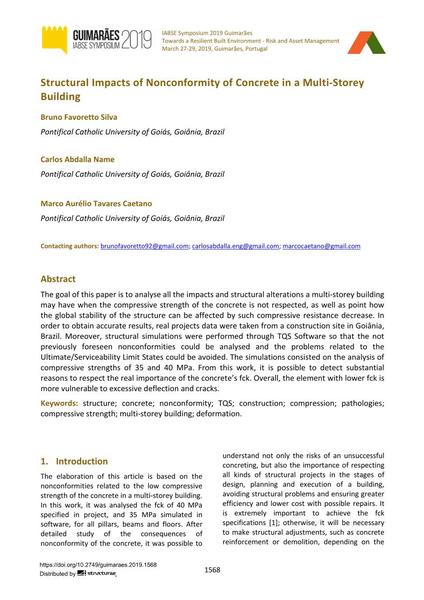Structural Impacts of Nonconformity of Concrete in a Multi-Storey Building

|
|
|||||||||||
Bibliographic Details
| Author(s): |
Bruno Favoretto Silva
(Pontifical Catholic University of Goiás, Goiânia, Brazil)
Carlos Abdalla Name (Pontifical Catholic University of Goiás, Goiânia, Brazil) Marco Aurélio Tavares Caetano (Pontifical Catholic University of Goiás, Goiânia, Brazil) |
||||
|---|---|---|---|---|---|
| Medium: | conference paper | ||||
| Language(s): | English | ||||
| Conference: | IABSE Symposium: Towards a Resilient Built Environment Risk and Asset Management, Guimarães, Portugal, 27-29 March 2019 | ||||
| Published in: | IABSE Symposium Guimarães 2019 | ||||
|
|||||
| Page(s): | 1568-1575 | ||||
| Total no. of pages: | 8 | ||||
| DOI: | 10.2749/guimaraes.2019.1568 | ||||
| Abstract: |
The goal of this paper is to analyse all the impacts and structural alterations a multi-storey building may have when the compressive strength of the concrete is not respected, as well as point how the global stability of the structure can be affected by such compressive resistance decrease. In order to obtain accurate results, real projects data were taken from a construction site in Goiânia, Brazil. Moreover, structural simulations were performed through TQS Software so that the not previously foreseen nonconformities could be analysed and the problems related to the Ultimate/Serviceability Limit States could be avoided. The simulations consisted on the analysis of compressive strengths of 35 and 40 MPa. From this work, it is possible to detect substantial reasons to respect the real importance of the concrete’s fck. Overall, the element with lower fck is more vulnerable to excessive deflection and cracks. |
||||
| Keywords: |
concrete structure construction compressive strength deformation compression multi-storey building nonconformity TQS pathologies
|
||||
